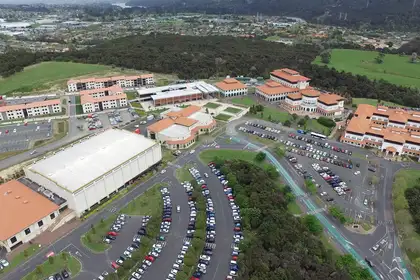
Massey's Auckland campus is located in Albany
Māori knew it as Ōkahukura, or “place of rainbows”. Early European settlers knew it as Lucas Creek. In 1890, it was re-named Albany after a fruit growing district in Australia. Over a century later, Albany is one of metropolitan Auckland’s newest suburbs.
Albany is also home to hundreds of newly arrived immigrants from mainland China.
Massey University researchers say the changes in Albany over the past quarter century are part of a global phenomenon emerging in Pacific Rim anglophone cities like Los Angeles, Vancouver, Sydney, and Melbourne.
School of Humanities, Media, and Creative Communication Senior Lecturer Dr Liangni Sally Liu says you can feel the Chinese influence in Albany.
“The idea for the research came when I invited eminent migration history scholar Professor Xiaoan Wu from Peking University to take up a visiting fellowship at Massey in 2018,” Dr Liu says.
“We often ate out at restaurants around the Albany area. As an outsider, he was very conscious of the Chinese presence and settlement in Albany. He said it would make an interesting ethnographic study.”
Since the mid-1990s, mainland China has become the second largest source of immigrants to New Zealand. But far from being a homogenous group, the research paper argues that China-born new immigrants can be divided into three distinct groups according to their time of arrival.
“The first group came in the early 1990s as postgraduate-level students on Chinese Government-funded scholarships. Most of them wanted to settle permanently because they were disappointed in the early stages of China’s economic reforms,” Dr Liu says.
Around the new millennium the second group arrived in their late teens or early 20s as self-funded international students, usually from wealthy families who were able to pay expensive international tuition fees. Many found work and stayed in New Zealand, while others went back to China or to a third country. Dr Liu herself fits into this group.
“The third and most recent group are what we call the “China Rising” generation who’ve made a lot of money in China’s fast developing economy. They are not primarily interested in economic opportunities. They’ve immigrated here with considerable settlement funds, looking for a better lifestyle and good education for their children.”
Where better to look than Albany, with its relatively safe neighbourhoods, family-friendly environment, reputable public and private schools, convenient public transportation connecting with central Auckland, and comprehensive public facilities and services?
“An ethnoburb is not the same as an ethnic enclave or a Chinatown, which traditionally attracted the less-advantaged,” Dr Liu says.

Dr Sally Liu
Albany used to be a rural area, until Auckland City Council’s urbanisation project got underway 30 years ago. The resulting new infrastructure, like the library, stadium, swimming pool, shopping centres, and community services, provide a base to attract new immigrants.
“Rapid real estate development went hand in hand with that. Chinese immigrants liked new houses made of modern building materials, and they could afford them.”
The research shows most Chinese homeowners in Albany are Mandarin speakers. The 2018 census counted 1704 mainland Chinese in Albany, representing nearly 19 per cent of the overall population in the Albany area. Many households are multigenerational families with grandparents, parents and grandchildren living together.
“We also found different generations often pooled their financial resources to buy an expensive property in Albany, with a significant amount of money generated from China.”
Unsurprisingly, the growing mainland Chinese population in Albany has been accompanied by a growth in Chinese-run businesses. The research found that apart from the retail businesses in Westfield shopping mall, over 40 per cent of other retail businesses in Albany are Chinese-owned, of which 60 per cent are restaurants, cafés, or bars. Chinese also own six supermarkets and five medical services.
Dr Liu notes that there is not just one Chinese business cluster in Albany. “There are several, and the residential areas where Chinese choose to live are also scattered across six different areas of Albany.”
Therein lies the difference between early Chinese settlement patterns and the modern phenomenon of the ethnoburb. An ethnoburb is defined as a suburb with multi-ethnic communities and a significant concentration of one ethnic group, where scattered residential and business clusters co-exist.
“The early Chinese diaspora were drawn to Chinatowns or certain inner-city areas for a sense of security, familiar language and cultural surroundings, and most importantly for economic survival,” Dr Liu explains.
“All the respondents in our survey said that easy access to the Chinese supermarkets, restaurants, and shops and services motivated them to choose to live in Albany.
“No one said they chose Albany because the presence of other Chinese made them feel safer or gave them a sense of belonging.”
Dr Liu’s research is ongoing. So far, she has seen no evidence that psychological factors, a desire for the cultural comfort and security offered by the close presence of other Chinese families, have underpinned the decision to settle in Albany. However, further in-depth interviews are planned.
Dr Liu’s article ‘The Making of an Ethnoburb: Studying Sub‑ethnicities of the China‑born New Immigrants in Albany, New Zealand’s was recently published in Springer Science + Business Media’s journal Integrative Psychological and Behavioural Science. The article was co-authored with Dr Robert Didham (Statistics New Zealand), Professor Xiaoan Wu (now with Huaqiao University’s Research Institute of Global Chinese and Area Studies), and Zhihan Wang, PhD candidate in Massey’s School of Natural and Computational Sciences. Springer Science + Business Media’s journal Integrative Phycological and Behavioural Science
Dr Liu has also recently authored a book called New Chinese Immigrants in New Zealand: Floating Families? with PhD graduate Dr Guanyu Jason Ran (currently a Lecture at Waikato Institute of Technology) that looks at Chinese immigrant families in New Zealand.
Related news
New book looks at experiences of Chinese immigrant families in New Zealand
A new book co-authored by Senior Lecturer Dr Liangni Sally Liu and PhD graduate Dr Guanyu Jason Ran looks at Chinese immigrant families in New Zealand.

Chinese migrants and elderly parents - Marsden study
Government policy changes in New Zealand and China are creating pressures for only child migrants from China who face difficult decisions juggling new lives with cultural expectations to care for ageing parents.

Interactive tool maps Auckland’s superdiversity
A new interactive tool that visually displays data about Auckland's fast-growing and increasingly diverse migrant population will give government agencies, and groups such as employers and the media, a detailed understanding of superdiversity.
